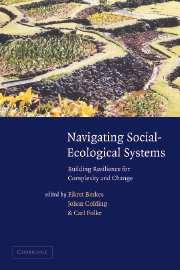Book contents
- Frontmatter
- Contents
- List of contributors
- Preface
- Acknowledgements
- Foreword: The backloop to sustainability
- 1 Introduction
- Part I Perspectives on resilience
- Part II Building resilience in local management systems
- 5 The strategy of the commons: history and property rights in central Sweden
- 6 Management practices for building adaptive capacity: a case from northern Tanzania
- 7 Living with disturbance: building resilience in social–ecological systems
- Part III Social-ecological learning and adaptation
- Part IV Cross-scale institutional response to change
- Index
- References
7 - Living with disturbance: building resilience in social–ecological systems
Published online by Cambridge University Press: 13 August 2009
- Frontmatter
- Contents
- List of contributors
- Preface
- Acknowledgements
- Foreword: The backloop to sustainability
- 1 Introduction
- Part I Perspectives on resilience
- Part II Building resilience in local management systems
- 5 The strategy of the commons: history and property rights in central Sweden
- 6 Management practices for building adaptive capacity: a case from northern Tanzania
- 7 Living with disturbance: building resilience in social–ecological systems
- Part III Social-ecological learning and adaptation
- Part IV Cross-scale institutional response to change
- Index
- References
Summary
Introduction
Disturbances such as fire, cyclones, and pest outbreaks create variation in natural systems and ecosystem renewal that may be important for the maintenance of biological diversity. Many natural disturbances are inherent in the internal dynamics of ecosystems, and often set the timing of ecosystem renewal processes fundamental for maintaining resilience in ecosystems (Holling et al., 1995).
By disturbance we mean ‘any relatively discrete event in time that disrupts ecosystem community or population structure and changes resources, substrate availability, or the physical environment’ (White and Pickett, 1985: 7). We distinguish between abiotic and biotic disturbances. Abiotic disturbances are those where the direct cause of disturbance is generated by nonbiotic agents. Examples include fires, hurricanes, volcanic eruptions, earthquakes, flooding, and drought. Examples of biotic disturbances include insect and pest attacks, predators, invasion of exotic species, and the grazing and browsing of herbivores.
Conventional resource management, based on economic production targets, commonly seeks to reduce natural variation in target resources, because fluctuations impose problems for the industry dependent on the resource (Holling and Meffe, 1996). Control of resource stock variability and flows can be achieved in a number of ways. For instance, by increasing financial investments in technologies for harvesting, a modern fishing industry can invest in larger fleets and more effective gear in order to maintain an even flow of production. Maintenance of high and even flows of monoculture crops in large-scale agriculture may be achieved by investing in various energy inputs, such as insecticides, pesticides, and irrigation.
- Type
- Chapter
- Information
- Navigating Social-Ecological SystemsBuilding Resilience for Complexity and Change, pp. 163 - 186Publisher: Cambridge University PressPrint publication year: 2002
References
- 13
- Cited by



